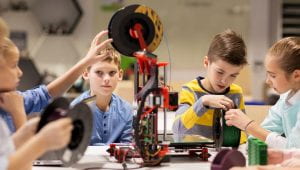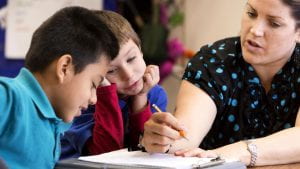April 2019 archive
 In a traditional learning environment, foundational content is presented by the teacher, digested by the students, and restated to the teacher by the students.
In a traditional learning environment, foundational content is presented by the teacher, digested by the students, and restated to the teacher by the students.
When students do not master that foundational content before they move on to the advanced concepts, they lose focus and purpose. They become strategic about ‘chasing points’ and performing just well enough to ‘not get hassled.’
Since most adolescents do not see the bigger picture of learning and engagement and are not intrinsically motivated by grades and points, the Project-Based Learning (PBL) model offers a way to maintain a high level of student engagement while assessing for mastery.
PBL is a comprehensive student-centered pedagogical approach to learning involving a dynamic classroom methodology. PBL is unlike traditional leaning because it does not move in lock-step with teacher directions. In traditional learning, students are presented with content by the teacher, the student, in turn, memorizes the provided content, and to demonstrate learning; the student offers the same content back to the teacher (i.e., standardized test).
In PBL, the teacher presents a problem or issue to be solved, the student identifies the key components, takes action based on identification, and to demonstrate learning, the student applies both prior knowledge and content knowledge to solve the problem.
In addition, PBL offers the unique feature of public presentation. Students present conclusions and solutions to the presented problem or issue publicly instead of in a silo of student-teacher communication. PBL’s design is distinctive because unlike traditional learning — which mainly focuses on linearly transmitting information, the PBL design focuses on deepening holistic understanding.
The instructional focus of PBL is student ownership. PBL affords students an opportunity to take ownership of their own learning as well as provide opportunities to collaborate with peers and solve practical problems utilizing a variety of tools such as data, research, and analysis. Further, there is an instructional focus on generating new and creative ideas, projects, and plans all while communicating and sharing solutions with real-world audiences publicly.
The PBL method also enables students to visualize the timeline of events and provides students with many avenues to ‘show what they know.’ By helping students visualize how events actually unfold, PBL enforces research, writing, discussions, and reflections that enforce problem-solving, critical thinking, and content application skills as final products for assessment.
The assessment focus of PBL is authentic assessment. Authentic assessment is a way for students to show they can use what they have learned in the real world. When students are given the option to produce a PBL assignment they are provided an opportunity to utilize all aspects of the standards-based grading model and demonstrate a depth of the level of mastery not found in any traditional test, however they still receive a traditional letter grade. Authentic assessments are interactive and have a substance that affects deeper and more holistic learning. Authentic assessment is where mastery of information means the content is internalized, connected, and learned.
The goal of PBL is to facilitate learning, foster self-directed learners, and craft critical thinking. The PBL Model also involves being a teacher-coach, letting go of preconceived notions of classroom responsibility, putting teacher control in check, and motivating students to uncover informational content with depth and breadth. PBL is more than a learning process; it is a human process, a social process, a process which produces indelible results.
 Project-Based Learning (PBL) is a comprehensive student-centered pedagogical approach to learning involving a dynamic classroom methodology.
Project-Based Learning (PBL) is a comprehensive student-centered pedagogical approach to learning involving a dynamic classroom methodology.
PBL activates student engagement – and engaged students acquire more in-depth knowledge because they are actively exploring real-world challenges and investigating authentic problems.
A hallmark of a PBL lesson is making student work public and what better way to meet that goal than through the utilization of technology.
After the presentation of the driving question, students often have to organize their thoughts. This can be done successfully through prewriting. During prewriting, the use of graphic organizers in a software version can help students color code their prewriting while organizing their thoughts around the driving question.
The further use of a color-coded graphic organizer may be helpful to visually keep track of ideas — ideas to keep, ideas to discard, and ideas to investigate further while they examine a variety of primary and secondary sources to aid in the development of their opinions. Sites such as Mind42, MindMap, and WiseMapping are excellent tools to help the student keep track of brainstorming ideas and theories in a graphic organizer format.
As the students continue to work through the PBL process they will undoubtedly be required to produce a written document. During the drafting and revision stages of the writing process, Microsoft Word and Google Read & Write offer familiar and user-friendly options for most students. These products offer students an effortless method to change the text by deleting, adding, and moving paragraphs to improve quality. Word processing software further offers students a simpler option to incorporate feedback, add transitional information, and correct mechanics. Lastly, electronic dictionaries and thesaurus should not be discounted as they offer additional options for students to edit the revisions for spelling corrections and enhancement of vocabulary choices.
If using Google Read & Write, this software offers the students an additional feature – text-to-speech. This program has an automatic speaking and grammar check embedded in the program which provides immediate feedback to the student, thereby, improving writing during this stage of development.
The ubiquitous nature of technology allows students to make their work public by sharing work along numerous multi-media platforms. First, collaborative tools such as Google Docs allow the students to share work at various stages of the project with both the teacher and peers, in order to gain feedback. This, in turn, allows the timely integration of feedback before the final publication. Second, an online writing portfolio can offer students, peers, and teachers access to works in progress in order to offer suggestions, feedback, ask questions, and talk about portfolio items; all enhancing the final student work product. Lastly, any number of media can provide for student presentation of the final PBL project. Software programs such as Microsoft PowerPoint, Google Slides, Canva, and Keynote (for MAC) — just to name a few.
Teachers can benefit through the use of technology, not only to provide quick feedback but also to assist students if they begin to stray from the topic, challenge students to reach further in their work, as well as anchor learning targets. Utilizing technology in the classroom can be fun and provide avenues of creativity not found in traditional projects —for both students and teachers.
 How often do students groan when a paper is handed back to them for revisions?
How often do students groan when a paper is handed back to them for revisions?
Maybe they handed in a mind map to chart their idea, a brainstorm paper to list out possibilities, or even a first draft of a longer composition piece thinking the assignment was complete —only for it to reappear.
Students typically view the writing process as a “one and done”. A document they are asked to produce, they produce it, and it’s over. Novice writers often do not contemplate the importance of the prewriting, drafting, and revision steps of the writing process.
Students may overlook these steps because they are not readily practiced in the classroom. While drafting a paper is commonplace providing students a roadmap to the drafting process is not; this includes prewriting and revision. However, just as it would be unreasonable to build a house without using blueprints, it is unreasonable to ask students to draft well thought out, meaningful papers, when they have not created the ‘blueprints’ for the paper. This is where instruction concerning the writing process is critical.
Prewriting is akin to this blueprint analogy. Since prewriting is a writing preparation process that takes place before drafting, the prewriting process increases a writer’s efficiency and clarity by helping organize thoughts, map out, plan, and brainstorm ideas. Some prewriting processes are short; however, most are involved and require mental organization. Prewriting is not concerned with writing mechanics such as grammar or structure; it is merely a process to take ideas and translate those ideas to paper, often in fragments.
When prewriting is complete, and thoughts are on paper, they can be organized into a draft. While this is usually the end of the writing process in the classroom — it should not be. The process of drafting and re-drafting is a continuous improvement process each person must cycle through to perfect a document. The re-drafting of a paper is an integral part of the writing processed called revision.
The process of re-drafting, or revision, is central to the art of writing and plays a vital role in the writing process. Revision allows the writer to crystallize the thesis statement and provide support for the developed ideas. This may involve significant changes to the papers thesis statement as it moves from larger concepts to more discreet ones. Revisions may include the deletion, shifting, or rewording whole paragraphs, adding additional supporting evidence, or minimizing or expounding upon the text for an idea.
A word of caution —care must be taken not to confuse revision and editing. Editing is concerned with writing mechanics such as grammar and spelling whereas revision is concerned with content understanding can clarity.
Taking the time upfront to walk through the writing process with students, providing a writing roadmap they can utilize to guide them through the writing process and allowing the number of revisions necessary to make the writing process meaningful for the students are all parts of teaching a successful writing process.
As time passes in the classroom, the writing process becomes a more seamless process, where students know what to expect and how to perform, in turn, gaining necessary skills which will last a lifetime.
 In my last post Reflections on Classroom Management: Refusal in the Classroom – Part II, I reflected on the refusal in Mr. P’s class and different strategies to build relationships which may be helpful to Mr. P in turning “refusers” in to “participants”.
In my last post Reflections on Classroom Management: Refusal in the Classroom – Part II, I reflected on the refusal in Mr. P’s class and different strategies to build relationships which may be helpful to Mr. P in turning “refusers” in to “participants”.
In this third and final post, Reflections on Classroom Management: Disrespect in the Classroom – Part III, I reflect on the practice of individual focus on a singular student’s disrespectful behavior.
I begin every reflection concerning behavior with the same question “What is this student trying to communicate through this behavior?” I believe all behavior is a form of communication and decoding the communication of behavior is important.
The final scenario I reflected on concerned Mr. R. and his one disrespectful student, J.
Mr. R is a 9th grade World History teacher and he is concerned about a disrespectful student in the class. When Mr. R confronted the disrespectful student “J” about her attitude, she smirked, rolled her eyes, and muttered under her breath. The principal has made an announcement that no one should send students to the office and that all discipline problems should be handled in class. Mr. R has tried to contact J’s parents but has had no success. J continues to show disrespect daily.
Just as a teacher’s attitude and behavior can affect classroom culture, a disrespectful student can change the entire climate of the classroom; from a positive learning environment to a negative one.
This negative climate can permeate, silently undermining a positive culture, and giving other students implicit permission to be disrespectful as well. The way in which the teacher handle’s such a student is critical and can mean the difference between keeping —and losing— control of the class.
Mr. R’s difficulty with a singular student seems to require an individual solution. One such solution may be precise praise. Precise praise speaks to making positive reinforcement a strategy for the classroom while also separating mere acknowledgment from praise. Perhaps if Mr. R caught J doing something right, and came to her for the explicit purpose of positive reinforcement through praise, it would help shape J’s future behavior because the positive feedback would encourage her to continue to strive to meet Mr. R’s high expectations.
However, sometimes there is a need for critical feedback, and that feedback may be more impactful if it is delivered privately. There is power in privately delivered feedback. If the critical feedback is delivered privately, it will allow Mr. R and J to be the only ones to share in that feedback and allow any negative or embarrassing feelings to subside more quickly than if J felt she had to take defensive action for the benefit of her classmates.
J may also be more willing to correct negative behavior if she believes the privately delivered feedback was individual to her, for her, and only for her – making her feel special. However, whether the feedback is critical or positive, when the precise feedback is delivered it needs to be authentic to be memorable and genuine to be effective.
Second, Mr. R could take advantage of private feedback by perhaps establishing a set of prompts to remind J when she is exhibiting disrespectful behavior. This could help draw J back into a cooperative posture. Using a positive tone (the same tone that was hopefully delivered in the private feedback sessions) will add a bit of individuality for J when constructive feedback has to be delivered in public.
In conclusion, it is essential for a teacher not to take disruptive behavior personally. While students who are disruptive in the class have many motivations, rarely are those motivations malicious or its roots against the teacher personally. In other words, the teacher could be anyone if identical internal, external, and environmental factors remained constant.
The ability to stay calm, be polite, and treat even the most trying and disruptive of students with respect are necessary tools for every educator’s tool kit. Listen to what the disruptive students have to say and know that behavior is a form of communication.
 In a traditional learning environment, foundational content is presented by the teacher, digested by the students, and restated to the teacher by the students.
In a traditional learning environment, foundational content is presented by the teacher, digested by the students, and restated to the teacher by the students. Project-Based Learning (PBL) is a comprehensive student-centered pedagogical approach to learning involving a dynamic classroom methodology.
Project-Based Learning (PBL) is a comprehensive student-centered pedagogical approach to learning involving a dynamic classroom methodology. How often do students groan when a paper is handed back to them for revisions?
How often do students groan when a paper is handed back to them for revisions? In my last post Reflections on Classroom Management: Refusal in the Classroom – Part II, I reflected on the refusal in Mr. P’s class and different strategies to build relationships which may be helpful to Mr. P in turning “refusers” in to “participants”.
In my last post Reflections on Classroom Management: Refusal in the Classroom – Part II, I reflected on the refusal in Mr. P’s class and different strategies to build relationships which may be helpful to Mr. P in turning “refusers” in to “participants”.